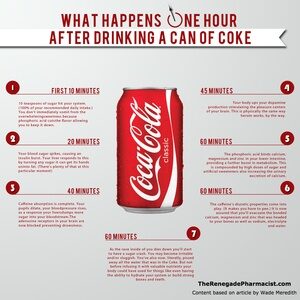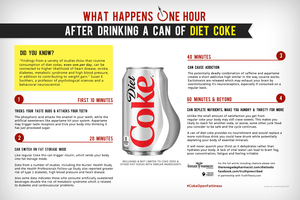An Infographic created by the site The Renegade Pharmacist in May has taken on a life of its own this week. The graphic, showing the effect of a can of soda on the body in an hour, peaked interest for many and went viral. The item was popular enough to spur a second graphic looking at the effects of a can of Diet Soda.
Although the Infographics received some criticism for their dramatic phrasing, the basic process explained seems to hold up. We also found it interesting that some experts played down the information stating that a can of soda every so often would not cause such issues to occur. Here it seems they miss the point of the whole thing. Of course the occasional consumer of these products will not have the same impact on them as someone drinking soda on a regular basis. That does not make the information less needed however.
We thought we might share these with you and look at some of the points brought out. We realize that many of you reading this stay away from soda and sugary drinks. This is offered as a continued encouragement, or as a resource for you as you try to encourage someone else.
Either way, here we go.
Effect of Can of Soda Over One Hour (text from the Infographic)
 1. In The First 10 minutes: 10 teaspoons of sugar hit your system. (100% of your recommended daily intake.) You don’t immediately vomit from the overwhelming sweetness because phosphoric acid and other flavorings cuts the flavor allowing you to keep it down.
1. In The First 10 minutes: 10 teaspoons of sugar hit your system. (100% of your recommended daily intake.) You don’t immediately vomit from the overwhelming sweetness because phosphoric acid and other flavorings cuts the flavor allowing you to keep it down.
2. 20 minutes: Your blood sugar spikes, causing an insulin burst. Your liver responds to this by turning any sugar it can get its hands on into fat. (There’s plenty of that at this particular moment)
3. 40 minutes: Caffeine absorption is complete. Your pupils dilate, your blood pressure rises, as a response your liver dumps more sugar into your bloodstream. The adenosine receptors in your brain are now blocked preventing drowsiness.
5. >60 minutes: The phosphoric acid binds calcium, magnesium and zinc in your lower intestine, providing a further boost in metabolism. This is compounded by high doses of sugar and artificial sweeteners also increasing the urinary excretion of calcium.
6. >60 Minutes: The caffeine’s diuretic properties come into play. (It makes you have to pee.) It is now assured that you’ll evacuate the bonded calcium, magnesium and zinc that was headed to your bones as well as sodium, electrolyte and water.
7. >60 minutes: As the rave inside of you dies down you’ll start to have a sugar crash. You may become irritable and/or sluggish. You’ve also now urinated away all the water that was in the Coke. But not before infusing it with valuable nutrients your body could have used for things like even having the ability to hydrate your system or build strong bones and teeth.
(Click Here for Full Article on Graphic)
Imagine the effect of this process when instead of a can you fill up with a Big Gulp size of soda. Multiply the effects of this process if you do. Drinks like this surround us every day, so it can be easy to become numb to ingredients and availability. Soda is a convenient add on to a meal deal and many restaurants offer unlimited refills. Going on autopilot with these points of access can help soda creep in to many venues in your life. As always, awareness plays a crucial role.
You might think that from this, sugar free options provide a better alternative. Unless the option happens to be water, likely the sugar free choice trades one harmful ingredient with several more horrible ones. Again this might all be something you completely understand in your daily life. If so, great. Perhaps then the following information will help you guide someone you love out of the treacherous path of the diet soda.
Effect of a Can of Diet Soda Over One Hour (text from the Infographic)
 First 10 Minutes – Tricks Your Taste Buds And Attacks Your Teeth
First 10 Minutes – Tricks Your Taste Buds And Attacks Your Teeth
The phosphoric acid attacks the enamel in your teeth, while the artificial sweeteners like aspartame hit your system. Aspartame may trigger taste receptors and trick your body into thinking it has just processed sugar.
20 Minutes – May Switch On Fat Storage Mode
Like regular Coke this can trigger insulin, which sends your body into fat storage mode.
Data from a number of studies, including the Nurses’ Health Study and the Health Professionals Follow-up Study also reported greater risk of type 2 diabetes, high blood pressure, heart disease and metabolic syndrome, which is related to diabetes and cardiovascular problems
Also some data indicated that those who consumed artificially sweetened beverages had double the risk of metabolic syndrome compared to non-consumers.
40 Minutes – Can Cause Addiction
The potentially deadly combination of caffeine and aspartame creates a short addictive high similar in the way cocaine works. Excitotoxins are released which may exhaust your brain by overstimulating it’s neuroreceptors, especially if consumed on a regular basis.
60 Minutes – Depletes Nutrients, Makes You Hungry & Thirsty For More
Unlike the small amount of satisfaction you get from regular coke your body may still crave sweets. This makes you likely to reach for another soda, or worse, some other junk food you consider to be safe and the cycle continues.
A can of diet coke provides no nourishment and would replace a more nutritious drink you could have drunk while potentially depleting your body of essential minerals
It will never quench your thirst as it dehydrates rather than hydrates your body. A lack of vital water can lead to brain fog, poor concentration, fatigue and feeling irritable.
So there you have it, a few more reasons to stay clear of soda in its many forms. We appreciate the folks at The Renegade Pharmacist for being willing to gather the information together. If you follow the different links for the Infographics you will find additional research links and such for the data provided.
Most of the time knowledge is power.
Understanding how the body processes such products provides you with a stronger argument than just “don’t drink it – it’s bad for you.” Rarely does that approach seem to work. When the details of what happens present themselves, then it engages a person in a different way. Empowering with knowledge offers a chance to engage in conversation rather than a lecture.
What are your thoughts? As always we love to hear from you and your direct experience. Take a moment to write a comment and add to the dialogue. You know you want to.
Have a great weekend and as always – To Your Health.

